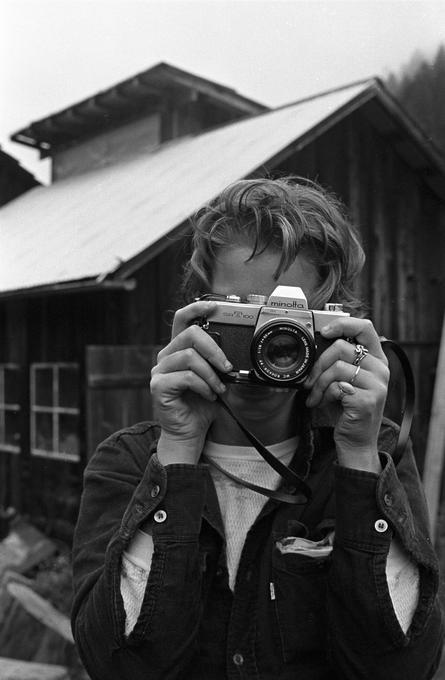
Untitled, by unknown artist, 1950-1959. University of Oregon, Ruth Moutaingrove papers.
Look at her. I wonder if she’s smiling behind the camera. If she burst out laughing with her companion after they snapped photos of one another. I wonder what her name is, and whether this was where she called her true home.
She was probably a lesbian. Though we don’t know who she or the artist of this photo was, this image comes to us from the Ruth Mountaingrove papers held by the University of Oregon. And that origin says a lot.
Ruth Mountaingrove (1923 – 2016) was a photographer, writer, poet, and artist who moved to Oregon in 1971. She joined the community of Mountain Grove, a lesbian commune where she lived for two years with her partner, Jean. She eventually co-founded Rootworks, a lesbian land in Southern Oregon. At Rootworks, Ruth and others led photography workshops aimed at empowering women through art. Photos were a way for these women to examine the differences between the way men pictures women and the way women saw themselves.
Communities like Mountain Grove and Rootworks were places that helped lesbians increase their visibility, moving out of bars and private homes and into the public sphere for the first time. These communities helped broaden the variety of spaces and services available to lesbian women (and other LGBTQ individuals), including social events, political demonstrations, church services, baseball games, and crisis centers. They were also a direct response to the Second Wave of feminism, which had ignored lesbianism. Second Wave feminists had even been hostile to lesbians, calling them the “Lavender Menace” that undermined feminist credibility.
Closeted for decades, even centuries, the 1970s were the start of a remarkable transformation for lesbian women and other non-normative sexualities and genders. During this decade, gay culture (primarily for men) became more visible, with the first on-screen kiss of two men, the first gay television movie, the release of Cabaret, and the start of Gay Pride Week. Most significantly, in 1973, the American Psychiatric Association voted unanimously to “remove homosexuality from its list of psychiatric disorders”.
This photograph is a testament to the power of women’s communities in empowering non-normative groups. According to Heather Jo Burmeister of Portland State University, these lands or communes were integral to developing and commodifying lesbian-produced art. The women in these groups shared everything: power, money, responsibilities, knowledge, land, and lovers. They also were safe spaces for women to recreate themselves, affirm their gender or sexual identity in the face of systemic oppression, and create cultural contributions that continue to inspire and impact us today.
These women, both the photographer and the photographed, were inspirations for a generation of young girls to come out of the closet, embrace their artistic abilities, and find (or even create) a place where they truly belonged. Their courage and fortitude helped foster a better world, and led the way into an era of profound social change in the U.S.
I hope they roared with laughter.
-Tiffany Rhoades
Program Developer
Girl Museum Inc.
Read the entirety of Heather Jo Burmeister’s dissertation, “Rural Revolution: Documenting the Lesbian Land Communities of Southern Oregon”, here.
Explore the entire Ruth Mountaingrove collection here.
This post is part of our 52 Objects in the History of Girlhood exhibition. Each week during 2017, we explore a historical object and its relation to girls’ history. Stay tuned to discover the incredible history of girls, and be sure to visit the complete exhibition to discover the integral role girls have played since the dawn of time.
